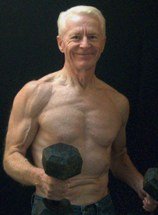| Back to Back Issues Page |
 |
|
The Gray Iron Fitness Newsletter, Issue #214. Stability balls. November 01, 2017 |
Hi
November 1, 2017
In this newsletter . . . Stability BallsThank you for the notes, thoughts and prayers for my nearby neighbors who lost their homes or were displaced by the wildfires here in northern California. They are returning home now from shelters and have begun the monumental job of rebuilding. Some of my family were made to evacuate, and stayed with us, but fortunately their homes were spared. –LF Should you add a stability ball to your home gym? I have a few thoughts.
Stability balls are fairly recent additions to gyms in the United States. But they’ve been used in Europe since 1963, after being developed by Aquilino Cosani, an Italian plastics manufacturer. In Europe, ball techniques became part of adult treatment for orthopedic or medical problems. They became known as "Swiss Balls" when American physical therapists started using them after seeing their benefits in Switzerland. Today, they go by a number of different names: stability ball, Swiss ball, fitness ball, yoga ball, and others. They’re made of elastic PVC and look like giant beach balls that vary in diameter from 14 to 34 inches. Originally used for physical therapy in clinical settings, ball exercises are found today in athletic departments or as part of home gyms and for general fitness training. Advocates of ball exercises for strength and fitness say a primary benefit is that your body must respond to the instability of the ball to remain balanced. This in turn engages more muscles than would normally be involved doing the same movements on a flat surface. Usually, the core muscles — those of the abdomen and back — are the focus of exercise ball programs. I’ve used fitness balls for abdominal and back exercises and found them to be a good option and a break from the more standard sit-up type movements and back extensions. I’ve also watched a highly fit woman at a gym do almost an entire full-body workout on a ball, moving gracefully and nonstop from one position to the next. It was impressive. On the other hand, I’ve seen some personal trainers have clients use the balls as benches for supine dumbbell pressing. I think that’s a very bad idea. Supposedly, high quality stability balls are "burst proof" and can handle substantial weight. That may be true -- most of the time. But not long ago I read a news report of a man breaking both arms when his exercise ball burst while he was supine pressing a heavy set of dumbbells. I would not use a ball for support while holding heavy weights above my body, even one that is labeled as "burst resistant." I’ve also seen some trainers have clients lift weights while balancing on Bosu balls (a Bosu ball looks kind of like an exercise ball that has been cut in half). The theory is that this training recruits stabilizer muscles while improving your sense of balance. I don’t like that idea either. I think seniors trying to balance on unstable objects while lifting weights is dangerous. If your goal is to simply improve your balance, I think yoga, Tai Chi, or Pilates are better options. If you’re developing a home gym, I do recommend a quality stability ball for core training options. I would look for the "burst resistant" and/or the "slow to deflate" feature. Still, even with those safety features, I would never use it for doing exercises while holding heavy weights above my body, in either a supine or a standing position. What size ball should you have? It should be firm when inflated and when seated on it your thighs should be about parallel with the floor. Follow the manufacturer's recommended height-to-size guidelines and you will be fine. Properly used, stability balls add variety and fun to your workouts. Always open, 24/7: Senior Exercise Central.
If you like the newsletter, we're making it easy to share it . . .  Newsletter Policy The Gray Iron Fitness Newsletter is a free publication sent twice monthly to subscribers. The purpose is to provide honest and realistic fitness information for people age 50 and above. I have never been paid or received compensation of any kind to write a positive review or endorse a product. If I say that I personally use a product or service, it is because I find value in it and have paid for it with my own money. Like newspapers, magazines and television, this newsletter and my web site contain advertising and marketing links. Naturally, I am compensated for these. The newsletter and web site provide information to help users establish and maintain a fitness lifestyle. But fitness information is not the same as fitness advice, which is the application of exercise and dietary practices to an individual's specific circumstances. Therefore, always consult with your physician for assurance that fitness information, and your interpretation of it, is appropriate for you. Your comments and questions are always appreciated. Simply click on the "Reply" bottom. |
| Back to Back Issues Page |